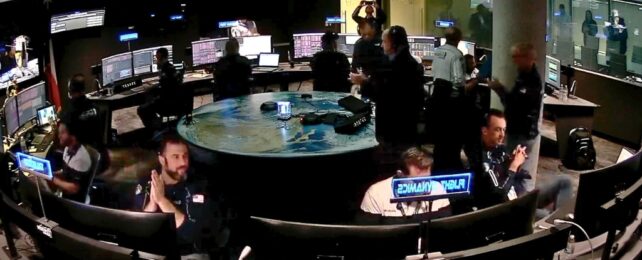The US company Intuitive Machines has successfully put its Odysseus lunar lander on the Moon's surface in a landmark achievement in space exploration by the private sector.
Calling it a white-knuckle ride to the end is an understatement. Slowing down from a velocity of 1.8 kilometers (1.1 miles) per second after crossing a gulf 400,000 kilometers wide, the lander had to come to a full stop with pin-point precision.
As the lander slowed to land, communications were cut, making Odysseus a fully autonomous system.
For fifteen long minutes after the mission control team expected to hear from the lander, there was still silence. Beyond troubleshooting malfunctions prior to descent, there's not a great deal mission control can do should things go wrong, except wait to hear.
Then, a whisper was heard. Faint, but it was enough.
Your order was delivered… to the Moon! 📦@Int_Machines' uncrewed lunar lander landed at 6:23pm ET (2323 UTC), bringing NASA science to the Moon's surface. These instruments will prepare us for future human exploration of the Moon under #Artemis. pic.twitter.com/sS0poiWxrU
— NASA (@NASA) February 22, 2024
At 17:38 CT the landing vehicle, nicknamed 'Odie' by its team, was confirmed to have set down in an impact crater called Malapart A, about 300 kilometers (180 miles) from the lunar south pole.
It wasn't all clear sailing in the lead-up to touchdown, with the system's laser-guidance system malfunctioning on the way in.
Fortunately NASA's payloads on the private mission included an operational lidar, which was patched in to guide the mission to the surface.
A little over half a century ago, NASA departed the lunar surface in what would be its final Apollo program mission. Today's achievement marks a return to the Moon for the US, in a form few might have once anticipated.

With the emergence of companies like Space X and Blue Origin, space exploration is increasingly being carried on the backs of commercial ventures.
Odysseus is the first mission by Intuitive Machines. Founded in 2013, it was one of nine companies selected by NASA permitted to bid as a payload service for government-funded programs.
This is the first successful landing of what is likely many such missions to come. Among several other privately funded payloads, NASA has six instruments on board, including a laser retroreflector to bounce back laser light from Earth, a low-frequency radio receiver for measuring charged particles on the Moon's surface, and an instrument in the propellant tank that uses a novel method for keeping track of fuel levels.
Over the next two weeks, Odysseus and its rover will make use of the fading sunlight to power its way through experiments that ought to help NASA with its plans to put people on the Moon's surface within the next few years.
Well done Odysseus! It's one small step we were all looking forward to.
